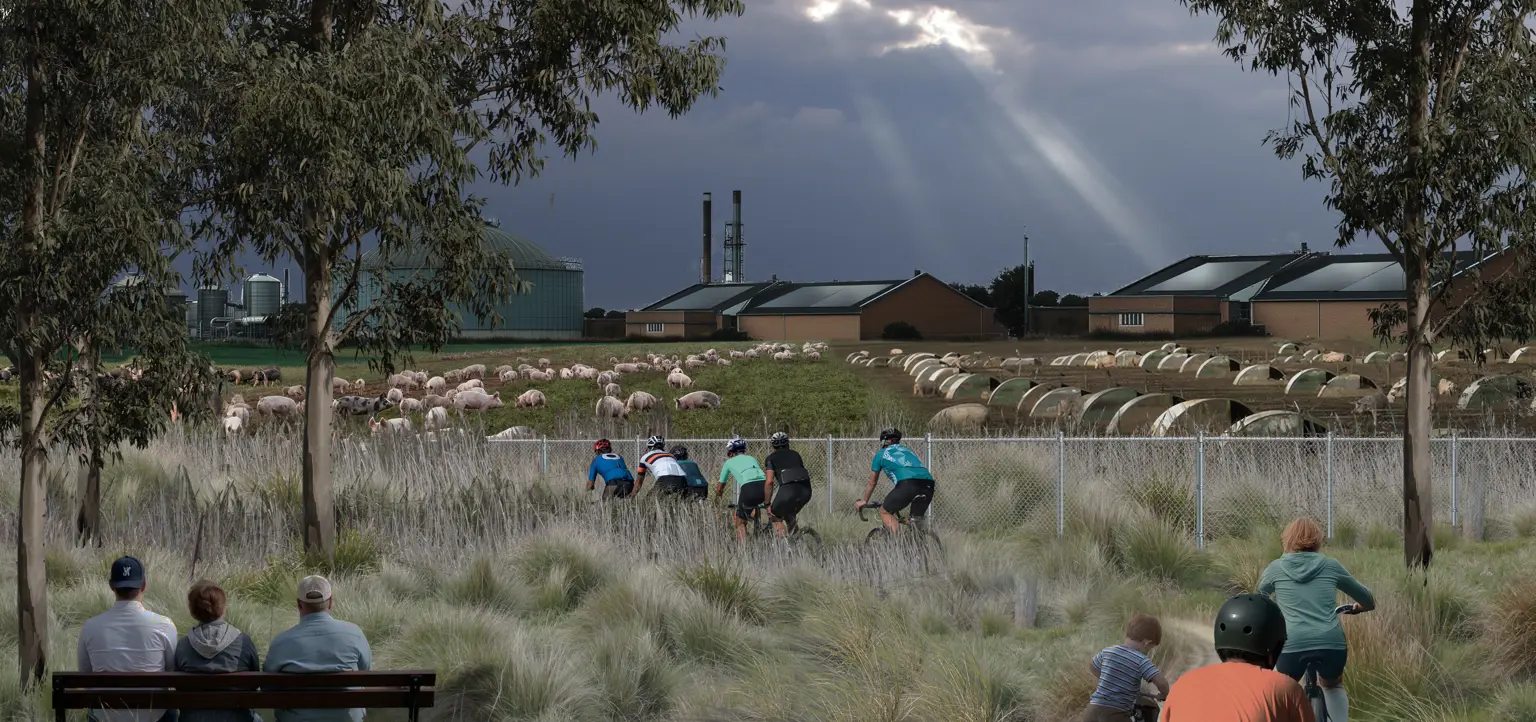Latrobe Valley community outlines vision for post-coal mine lands

One of a series of artist's impressions based on the research project’s community panel sessions. Image created by Candice Teok and Kyle Bush, RMIT University, 2025. Some elements in this image were generated using artificial intelligence (AI).
Enhanced biodiversity, new energy generation, affordable housing, spaces for recreation, food production and culture and arts spaces are among the community’s preferred uses for land around the Latrobe Valley’s post-coal mine sites, new research has found.
The Collaborative Planning for Post-Mine Land Use in the Latrobe Valley project has delivered its final report after two-and-a-half years of research including consultation with more than 100 participants across the Latrobe Valley including young people, Traditional Owners and the broader community.
The project is a partnership between Federation University Australia and Australia’s national science agency CSIRO, made possible through support from the Cooperative Research Centre for Transformations in Mining Economies (CRC TiME). Mine operators and relevant government departments also provided support.
The community’s vision for the future uses of the land surrounding the Latrobe Valley’s coal mines is also set in the report.
Almost 10,000ha of land adjacent to major towns with transportation infrastructure and rich biodiversity areas could be redeveloped in 20 to 50 years – through a combination of private and public means. In principle, rehabilitation and redevelopment of unmined areas of these sites could occur sooner.
The long-term vision has been prepared to help inform current landowners, mine operators, investors and government, to complement the mine closure planning processes and inform future development, acknowledging the many steps needed for it to be realised.
Researchers conducted an independent and comparable consultation processes with each group of participants, catering the approach to their needs.
Participants identified green spaces for nature-based recreation and healing Country, mixed density housing with community gardens, growing hemp on current grazing land, and sustainable food production like vertical farming among their preferred land uses. An advanced manufacturing hub and renewable energy developments were also identified.
Accessing the sites as soon as possible for recreation activities was supported by all participants, with Indigenous participants highlighting the need to regain access and connection to Country. The expansion of biking tracks and the inclusion of space for ‘noisy’ activities like motocross or outdoor live music venues were all supported.
Cultural heritage was considered essential by all cohorts, while ideas for remembering the importance of the region’s long industrial past were also supported.
The most strongly supported new energy source by the study’s community and youth cohorts was a geothermal loop, building on the existing infrastructure of the Gippsland Regional Aquatic Centre, to provide a gas replacement for heating and low temperature manufacturing, while acknowledging this was not a replacement for all electricity supply.
The scope for the research project was formed by a steering committee of the mine operators, relevant government departments, Traditional Owners and community organisations to ensure that the preferred land uses were feasible.
The broad range of project partners and steering committee members included AGL, Energy Australia, Engie, the Mine Land Rehabilitation Authority, Loy Yang B Power Station, Latrobe City Council, Gunaikurnai Land and Waters Aboriginal Corporation, the Victorian Department of Energy, Environment and Climate Action, the Latrobe Valley Authority, Regional Development Victoria, the Latrobe Health Assembly and the Gippsland Trades and Labour Council.
Project researchers Associate Professor Jess Reeves from Federation University and Dr Tira Foran from CSIRO were recently presented with the ‘New Way Forward’ award at the 2025 CRC TiME Annual Forum, for setting a new benchmark in post-mining futures research by involving youth, community and Indigenous panels in their work.
The full synthesis report can be found at: https://crctime.com.au/project/project-1-7-2-collaborative-planning-for-post-mining-development-in-latrobe-valley/
The Cooperative Research Centre for Transformations in Mining Economies is supported by the Australian Government Department of Industry, Science and Resources Cooperative Research Centre Program. As part of its remit, CRC TiME works with industry, regional development, community, government and other partners across Australia.
This project is one in a portfolio of activities underway by CRC TiME to unlock post-mine transformations, including to understand post-mine land, asset and infrastructure use.
Quotes attributable to Federation University Australia Associate Professor Jess Reeves
“There is such a narrative of closure and risk in the Latrobe Valley, and we wanted to raise the opportunity and aspiration, particularly for young people and First Nations communities, to begin to see a positive future.”
“Our approach has enhanced the understanding within the community around mine closure and future land use options, to increase their agency and ability to participate in future discussions and decision-making.”
Quotes attributable to CSIRO Dr Tira Foran
“The project invited governments, mine licensees, the Native Title holders, and community organisations to form a new steering committee. This committee invited community members – including young people and First Nations participants – to develop visions for a post-mining future.”
“The committee provided essential knowledge and guidance and celebrated the final outputs. We believe this novel, collaboratively supported approach could underpin fresh planning initiatives in other settings too.”
Quotes attributable to CRC TiME CEO Dr Guy Boggs
“This project focussed on the connection between people and place. It has shown that taking a collaborative approach to planning for post-mining futures is crucial for moving from simply focussing on sites to taking the entire region into consideration, particularly in areas of multiple complex mine closures, like the Latrobe Valley.”
Recognising a wider range of values, value-holders and interests, including those of Traditional Owners, can help build a shared vision for the future – a central step to ensuring community voices are heard and contributing to their own regional transformations.”
We believe the process developed with the Latrobe Valley community also has the potential to assist other regions undergoing transformation and look forward to sharing lessons with others.”
